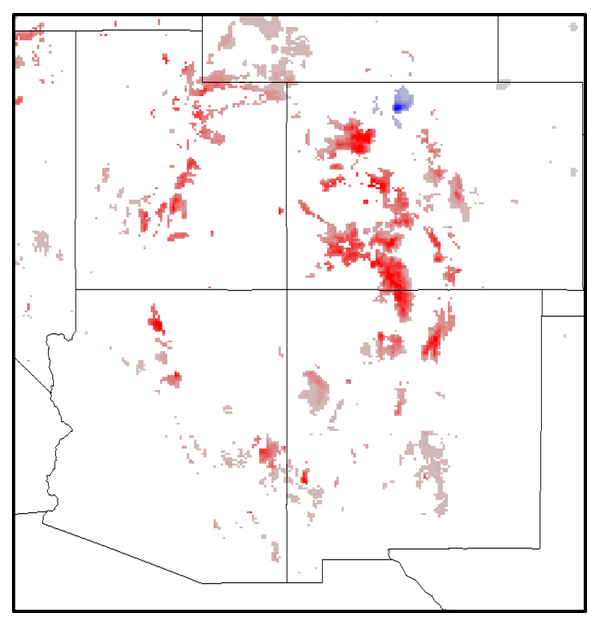Global warming taking toll on $20 billion ski industry – Snowpack in Western U.S. declined 41 percent from 1982 to 2016 – “Where is my livelihood in the future, in three to four, five years?”

By Diana Olick
21 March 2019
(CNBC) – Skiers in the western U.S. are enjoying one of the best seasons in years. But experts warn that years like this are quickly becoming the exception, not the rule.
Snow sport seasons are getting shorter, due to warmer temperatures. That is already having a distinguishable financial impact on residential and resort properties that profit from snow.
Vail Resorts, the largest player in the U.S. ski field, reported better-than-expected quarterly earnings in its latest report but had to lower its full-year guidance because of a weak start to the season. The company’s CEO, Robert Katz, attributed that “to guest concerns after two prior years of poor pre-holiday conditions.”
The amount of snow in the west has seen an average drop of 41 percent since the early 1980s, according to research just published in the journal Geophysical Research Letters. As a result, the snow season shrunk by 34 days.
Snow sports tourism contributes about $20 billion to the U.S. economy each year, according to researchers at the University of New Hampshire and Colorado State University. The bulk of that spending is at ski resorts, like Colorado-based Vail Resorts. […]
Home values in mountain towns like Vail and Aspen are some of the highest in the nation, and those values are at risk. By 2050, home values near ski resorts could drop by at least 15 percent due to warmer winters, according to a study by researchers at the University of Wisconsin. At lower elevation ski areas, such as in Utah, Idaho, Nevada and parts of California, they could fall as much as 55 percent.
Josh Lautenberg sells multimillion dollar homes in the Vail area, some of which are used for just a few winter months each year. He was stunned by the poor conditions to start last year’s ski season. […]
“So we do certainly worry that we wouldn’t be able to sustain one or two or three consecutive years low snow volume due to climate change,” Lautenberg said. “And as far as the real estate business that I own and that I also am a broker within, what will happen? You know, where is my livelihood in the future, in three to four, five years?” [more]
Climate change is taking a toll on the $20 billion ski industry
ABSTRACT: Snow water equivalent (SWE) variability and its drivers over different regions remain uncertain due to lack of representativeness of point measurements and deficiencies of existing coarse‐resolution SWE products. Here, for the first time, we quantify and understand the snowpack change from 1982 to 2016 over conterminous United States at 4‐km pixels. Annual maximum SWE decreased significantly (p < 0.05) by 41% on average for 13% of snowy pixels over western United States. Snow season was shortened significantly by 34 days on average for 9% of snowy pixels over the United States, primarily caused by earlier ending and later arrival of the season over western and eastern United States, respectively. October–March mean temperature and accumulated precipitation largely explain the temporal variability of 1 April SWE over western United States, and considering temperature alone would exaggerate the warming effect on SWE decrease. In contrast, temperature plays the primary role in the 1 April SWE variability over eastern United States.
SIGNIFICANCE: Snow is one of the most important wintertime land surface characteristics and is crucial for water resources over western United States. However, regional snow mass variability and its drivers remain uncertain. Based on our recently developed high‐quality gridded snow mass product, here, for the first time, we quantify and understand the snowpack change from 1982 to 2016 over conterminous United States (ConUS) at 4‐km pixels. Annual maximum snow mass decreases significantly by 41% on average for 13% of snowy pixels over the western United States (or the size of South Carolina). Over ConUS, snow season was shortened significantly by 34 days on average for 9% of the snowy pixels (or the size of Virginia). October–March mean temperature and accumulated precipitation largely explain the temporal variability of 1 April snow mass over western United States, and considering temperature alone would exaggerate the warming effect on the snow decrease. For the snowpack projection in the next few decades over United States to be reliable, Earth system models need to demonstrate their capability in reproducing historical snowpack variabilities and trends and their different relations with temperature and precipitation over western versus eastern ConUS, as reported here.
Snowpack Change From 1982 to 2016 Over Conterminous United States